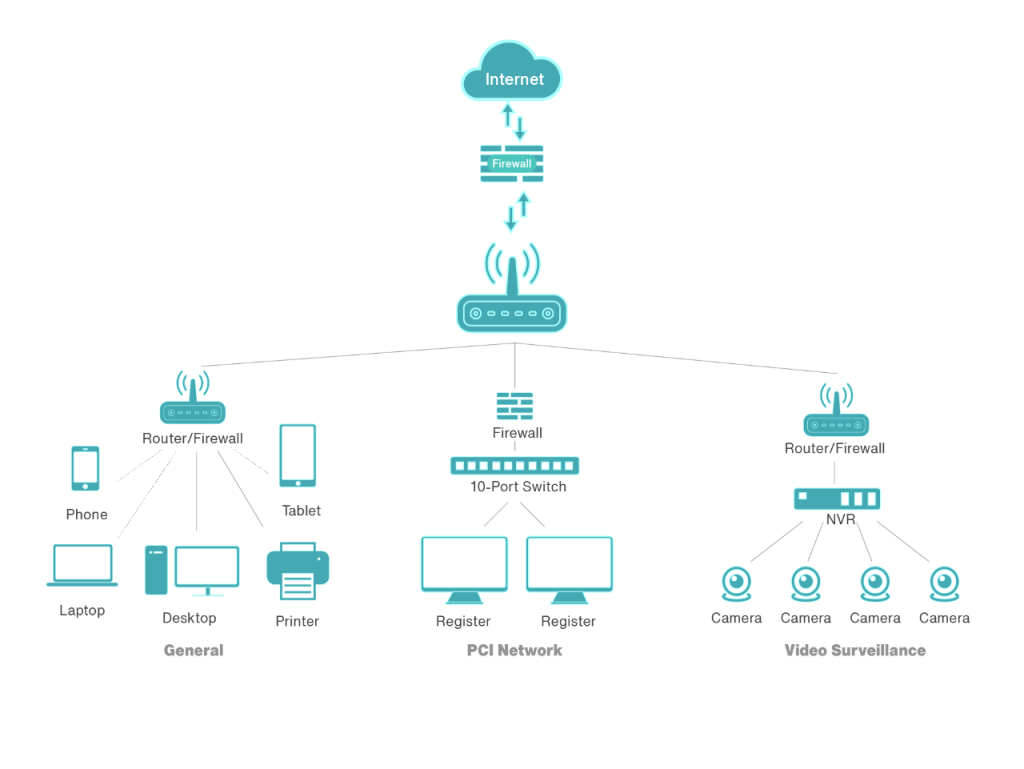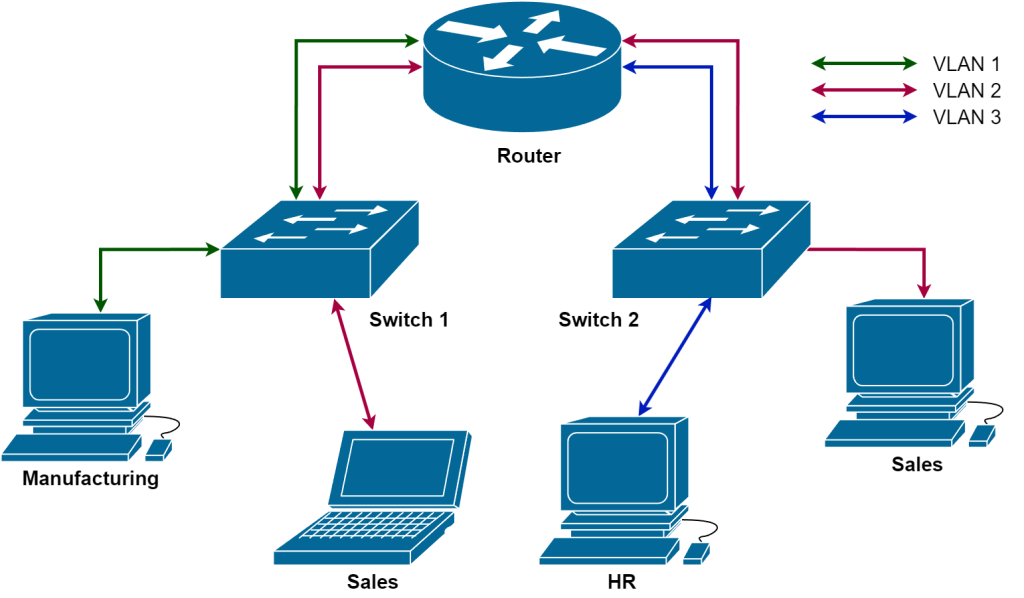Network segmentation in cybersecurity is one of the most effective but often overlooked strategies for protecting IT infrastructure. While firewalls and antivirus tools are important, they’re not enough on their own. While those tools are important, they’re not enough on their own. By breaking a network into smaller, isolated parts, organizations reduce the attack surface, improve performance, and gain better control over sensitive data.
Table of Contents
What is Network Segmentation?

At its core, network segmentation means dividing a network into logical or physical segments. Instead of having every system on one flat network where a single compromise can spread quickly, segmentation ensures that traffic between different groups of systems is restricted and monitored.
Think of it like watertight compartments on a ship. If one area floods, the others stay safe.
Why Network Segmentation Matters for Cybersecurity
Attackers rarely stop at their initial breach. Once inside, they attempt lateral movement jumping from one machine to another until they reach domain controllers, databases, or cloud resources. Without segmentation, this movement is almost frictionless.
Network segmentation strengthens cybersecurity by:
- Containing breaches: If an endpoint in HR is compromised, it can’t easily talk to finance systems.
- Protecting sensitive data: Cardholder data, medical records, or payroll information are walled off.
- Supporting compliance: Standards like PCI DSS, HIPAA, and SOC 2 specifically require segmentation or isolation of critical systems.
- Enhancing Zero Trust: Zero Trust assumes breach — segmentation enforces “least privilege” at the network level.
- Reducing attack surface: Fewer pathways mean fewer opportunities for malware, ransomware, or insider threats to spread.
- Improving performance: By segmenting traffic (e.g., VoIP, backups, video), networks can prioritize and optimize critical services.
Common Ways to Implement Network Segmentation
1. Router + Multiple Switches

- In this model, the router enforces segmentation. Each switch connects to a different subnet or VLAN, and the router decides what traffic can move between them.
- Pros:
- Clear separation of broadcast domains.
- Strong control at the router level.
- Scales well for smaller to mid-sized networks.
- Cons:
- More hardware (multiple switches).
- Can introduce latency if traffic must always go through the router for inter-VLAN communication.
2. Router + Backbone Switch

- Here, a single high-capacity backbone (core) switch handles VLANs and traffic internally, with the router mainly providing external connectivity and policy enforcement.
- Pros:
- Faster inter-VLAN routing (especially with Layer 3 switches).
- Less hardware sprawl.
- Centralized management of VLANs.
- Cons:
- Single point of failure if the backbone switch goes down.
- Can get complex in large deployments if not properly documented.
In practice:
- Smaller businesses often start with router + multiple switches.
- Larger enterprises lean toward a backbone/core switch with VLANs for scalability and speed.
- Hybrid models are common — backbone switches in the core, smaller access switches at the edge, all tied together with segmentation policies.
Approaches Across Environments
- On-Premises:
- VLANs (Virtual LANs): Separate traffic for departments or applications.
- Firewalls/ACLs: Control which traffic is allowed between VLANs.
- DMZs: Isolate public-facing systems from internal resources.
- Core services like DNS, DHCP, and VPN also play a vital role in how segmentation policies are applied and enforced. If you’d like a deeper dive into how these services support cloud administration, check out my article: DNS, DHCP, and VPN: The Hidden Heroes of Cloud Administration.
- Cloud & Hybrid:
- Azure Virtual Networks (VNets): Logical isolation in the cloud.
- NSGs (Network Security Groups): Enforce traffic filtering at the subnet or NIC level.
- Microsegmentation: Tools like VMware NSX or Kubernetes network policies enforce fine-grained security.
Common Mistakes to Avoid
- Flat networks: Still common in SMBs — easy to manage, but a security disaster.
- Over-segmentation: Too many micro-segments create unnecessary complexity and bottlenecks.
- Poor documentation: Without clear diagrams and policies, troubleshooting becomes a nightmare.
- No monitoring: Segmentation without logging/visibility = blind spots attackers can exploit.
Best Practices for Effective Segmentation
- Start with an inventory: Know which systems, apps, and data are most critical.
- Segment by business function, not just technology: HR, Finance, R&D — each should have its own zone.
- Define a clear security policy framework: Don’t just create segments randomly. Align segmentation rules with an overarching policy model.
- Diamond Model of Intrusion Analysis: Focuses on adversary, infrastructure, capability, and victim. Using this lens, you can design segmentation that limits attacker infrastructure (e.g., C2 traffic), restricts capabilities (e.g., lateral movement), and isolates high-value victims (sensitive assets).
- Modern Zero Trust Architectures (NIST SP 800-207, Microsoft Zero Trust): Enforce least privilege at the network layer, tying segmentation to identity, device posture, and context.
- MITRE ATT&CK mapping: Use segmentation to directly reduce opportunities for techniques like “Lateral Movement” or “Command and Control.”
- Pair segmentation with IAM controls: Use RBAC, MFA, and conditional access for layered defense.
- Use defense-in-depth: Combine segmentation with firewalls, IDS/IPS, and endpoint protection.
- Design for scalability and simplicity: Plan VLANs/subnets with future growth in mind, but avoid overcomplication.
- Document everything: Network diagrams, VLAN IDs, ACLs keep them updated and reviewed.
- Continuously monitor and test: Tools like Azure Monitor, Defender for Cloud, or SCOM help validate that traffic rules are enforced.
- Plan redundancy: Especially if using backbone switches avoid a single point of failure.
- Iterate regularly: Threats evolve, so revisit segmentation strategy during patch cycles, compliance audits, or after major architectural changes.
Final Thoughts
Network segmentation is one of the most powerful yet underutilized tools in cybersecurity. Whether it’s a small business using a router and a couple of switches, or a global enterprise running backbone switches and cloud microsegmentation, the principle is the same: limit the blast radius of an attack.
It’s not about making networks harder for admins; it’s about making them harder for attackers. And in a world of ransomware, insider threats, and evolving compliance demands, segmentation isn’t just a best practice — it’s a necessity.
Frequently Asked Questions (FAQ)
1. What is the purpose of network segmentation?
Network segmentation limits communication between systems by dividing a network into smaller zones. This improves security, reduces the attack surface, and helps organizations meet compliance requirements.
2. How does network segmentation improve cybersecurity?
By preventing lateral movement, segmentation contains breaches and isolates sensitive systems. Attackers who compromise one device cannot easily access others, which reduces overall impact.
3. What are the most common methods of network segmentation?
On-premises environments often use VLANs, firewalls, and ACLs. In cloud and hybrid setups, administrators rely on virtual networks (VNets), Network Security Groups (NSGs), and microsegmentation technologies like VMware NSX or Kubernetes policies.
4. What are the risks of poor network segmentation?
Flat networks, poor documentation, or overly complex segmentation rules can create blind spots and misconfigurations. These mistakes make it easier for attackers to exploit the network and harder for admins to manage.
